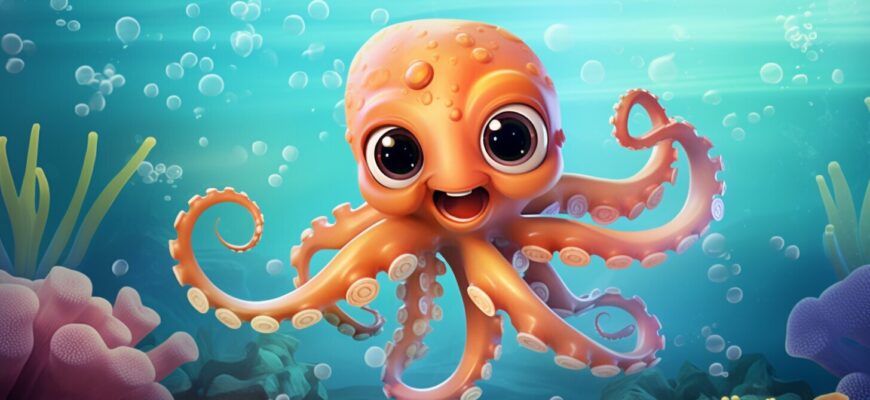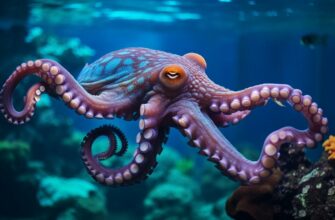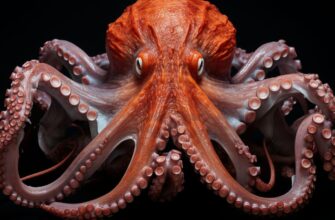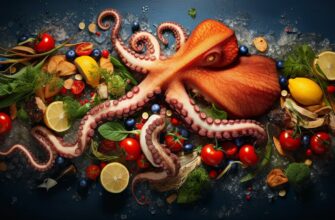Have you heard of the coconut octopus? These adorable creatures are fascinating examples of nature’s incredible abilities. They are known for their intelligence and remarkable camouflage skills, making them a marvel of the animal kingdom. Let’s dive deeper into the wonderful world of the coconut octopus.
Coconut octopuses are often considered one of the most intelligent species of octopus. They have a unique ability to solve problems and can even use tools to help them achieve their goals. Their intelligence, combined with their physical abilities, make them masters of their environment.
- Habitat and Distribution of the Coconut Octopus
- Physical Characteristics of the Coconut Octopus
- Behavior and Intelligence of the Coconut Octopus
- Tool Use
- Mimicry and Ambush Strategies
- Camouflage and Hunting Techniques of the Coconut Octopus
- Reproduction and Life Cycle of the Coconut Octopus
- Mating Behavior
- Egg-Laying Process
- Stages of Life Cycle
- Frequently Asked Questions about the Coconut Octopus
- What is the lifespan of a coconut octopus?
- What predators do coconut octopuses have?
- Are coconut octopuses endangered?
- How do coconut octopuses reproduce?
- What is unique about coconut octopuses’ camouflaging abilities?
- Do coconut octopuses show any social behavior?
Habitat and Distribution of the Coconut Octopus
The mesmerizing coconut octopus, also known as veined octopus, can be found in the tropical waters of the western Pacific Ocean, particularly in areas near Indonesia, Philippines, and northern Australia. These intelligent creatures prefer shallow waters with sandy or muddy substrates, mangrove swamps, and seagrass beds where they can find food and hide from predators. They are benthic creatures, which means they live on the ocean floor.
The natural habitat of the coconut octopus can range from depths of about 3 to 40 meters, but sightings have been recorded at deeper depths of up to 70 meters. They are known to be able to withstand low-oxygen environments by creating a small den or burrow where they can take refuge.
The geographical distribution of coconut octopuses is believed to be limited to the western Pacific Ocean, although their exact range is not yet fully understood. They are primarily found in the waters surrounding countries such as Indonesia, the Philippines, and Australia, and they are most commonly found in shallow waters where sunlight can penetrate the water surface.
Physical Characteristics of the Coconut Octopus
The coconut octopus, also known as the veined octopus, is a fascinating creature with a unique set of physical characteristics. This type of octopus has a soft, gelatinous body that is roughly the size of a softball, and is made up of eight long, flexible tentacles that are lined with suction cups. The coconut octopus can use these tentacles to move around and explore its environment, as well as to catch prey.
One of the most distinctive features of the coconut octopus is its ability to manipulate objects using its tentacles. This octopus is known to use coconut shells, shells from other types of mollusks, and even discarded human objects like bottle caps as shelters or tools for protection and hunting. They are also known to use these objects to relocate, dragging them across the ocean floor to their desired location.
The coconut octopus is also known for its remarkable camouflage abilities. This octopus can alter its skin color and texture to match the surrounding environment, effectively blending in with its surroundings and becoming invisible to predators. This ability is accomplished through the use of specialized pigment cells called chromatophores that allow the octopus to change color rapidly, as well as through the use of skin flaps and other physical adaptations that can mimic the texture and appearance of nearby objects.
Behavior and Intelligence of the Coconut Octopus
The coconut octopus is not only known for its remarkable physical abilities, but also for its advanced problem-solving skills and impressive intelligence.
Studies have shown that the coconut octopus is capable of using tools to solve problems, an ability previously thought to be unique to humans and primates. They have been observed using coconut shells as protective shelters, carrying them around for future use, and even manipulating them to create the perfect fit.
In addition, the coconut octopus is known for its remarkable behavior, including its ability to mimic other species and blend seamlessly into its surroundings. This behavior is used both for camouflage and hunting purposes, allowing the octopus to ambush prey with precision.
Tool Use
One of the most fascinating aspects of the coconut octopus’s problem-solving skills is its ability to use tools. In one study, scientists observed a coconut octopus using a shell as a protective shelter. The octopus was seen carrying the shell around with it, using it to hide from potential predators.
What’s even more impressive is that the coconut octopus was able to manipulate the shell to create the perfect fit. It was seen using its tentacles to adjust the position of the shell, ensuring that it was completely covered and protected.
Mimicry and Ambush Strategies
The coconut octopus is also known for its remarkable behavior when it comes to hunting. It has been observed using mimicry to imitate other species, such as sea snakes, in order to deter potential predators or lure prey.
Additionally, the coconut octopus uses ambush strategies to catch its prey. It will hide in crevices or under rocks, waiting for unsuspecting fish or other marine creatures to swim by. When the time is right, the coconut octopus will quickly pounce on its prey, using its powerful tentacles to capture and consume it.
Overall, the behavior and intelligence of the coconut octopus is truly remarkable. From its problem-solving skills and tool use to its mimicry and ambush strategies, this creature continues to fascinate and amaze scientists and nature enthusiasts alike.
Camouflage and Hunting Techniques of the Coconut Octopus
The coconut octopus is widely recognized for its remarkable camouflage abilities, utilizing a range of techniques to blend into its environment and avoid detection from predators. Additionally, they employ various hunting strategies to capture their prey. Let’s explore these fascinating behaviors in more detail.
Camouflage:
Coconut octopuses are masters of disguise, able to change their skin texture and color to blend in with their surroundings. They can mimic the texture and color of various objects, such as rocks, corals, and seaweed, making them nearly invisible to predators. They also use their surroundings to cover their bodies, using shells, coconut shells, and other discarded objects to hide.
Interestingly, these octopuses have been observed carrying these objects with them as they move through the water, suggesting that they are aware of their camouflage abilities and actively using them to avoid detection.
Hunting Techniques:
Coconut octopuses have been observed using a range of hunting strategies to capture their prey. One of their most common techniques is mimicry, which involves imitating the appearance and movements of other animals to lure in their prey.
For example, they have been observed mimicking the movements of crabs to fool them into getting close, before pouncing and capturing them. They have also been observed using an ambush method, hiding and waiting for their prey to pass by before quickly grabbing them.
In addition to these techniques, coconut octopuses have also been observed using tools to aid in their hunting. They have been known to use clam shells and coconut shells as weapons, cracking them open to access the meat inside. This behavior demonstrates their remarkable problem-solving skills and intelligence.
In conclusion, the coconut octopus is a truly remarkable creature, utilizing incredible camouflage abilities and employing a range of hunting strategies to survive in its environment. Its intelligence and problem-solving skills make it a true marvel of nature.
Reproduction and Life Cycle of the Coconut Octopus
The coconut octopus is a fascinating creature that has captivated the interest of many marine enthusiasts and scientists. In this section, we will take a closer look at the reproduction and life cycle of this incredible species.
Mating Behavior
The mating behavior of the coconut octopus has not been widely studied, but researchers believe it is similar to other octopus species. During mating season, the male will approach the female and attempt to mate. The male will transfer a packet of sperm, called a spermatophore, to the female’s mantle cavity. The female will then lay her eggs, which she will protect and care for until they hatch.
Egg-Laying Process
Female coconut octopuses typically lay their eggs in a sheltered area, such as a crevice or under a rock. The female will stay with the eggs and protect them until they hatch. During this time, she will not eat and may move the eggs if necessary to keep them safe from predators. The eggs will take several weeks to hatch, depending on the water temperature.
Stages of Life Cycle
After hatching, the young octopuses, called larvae, are planktonic and drift with the ocean currents. The larvae will feed on small organisms until they are big enough to settle on the ocean floor and transform into juveniles. As the juveniles mature, they will go through several stages of growth, shedding their skin as they grow. The exact length of the life cycle of a coconut octopus is not known, as it varies based on environmental factors such as food availability and water temperature.
The coconut octopus is a fascinating creature with a unique life cycle. Researchers continue to study this species in order to better understand its behavior and the environment in which it lives.
Frequently Asked Questions about the Coconut Octopus
What is the lifespan of a coconut octopus?
The lifespan of a coconut octopus in the wild is not yet fully understood, but in captivity, they can live up to three years.
What predators do coconut octopuses have?
Coconut octopuses have a number of natural predators, including eels, sharks, and other large fish that inhabit the same waters.
Are coconut octopuses endangered?
Currently, the coconut octopus is not considered endangered, but their populations may be threatened by pollution and habitat destruction in the future.
How do coconut octopuses reproduce?
Coconut octopuses reproduce sexually, with males using their specialized arm to place a spermatophore in the female’s mantle cavity.
What is unique about coconut octopuses’ camouflaging abilities?
Coconut octopuses are known for their remarkable ability to use objects in their environment to hide, such as carrying around coconut shells or clam shells to use for cover.
Do coconut octopuses show any social behavior?
While they are generally solitary creatures, coconut octopuses have been observed interacting with each other, sometimes using aggression or display behavior to establish dominance.









